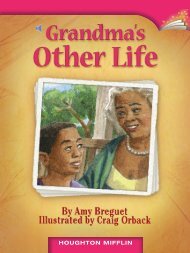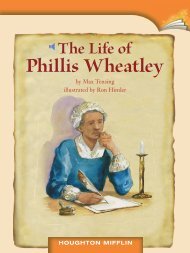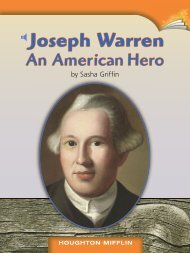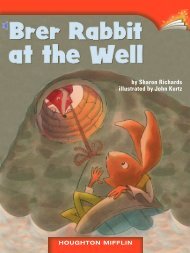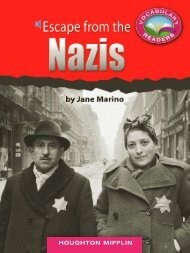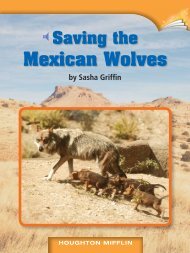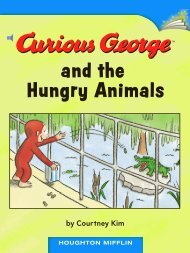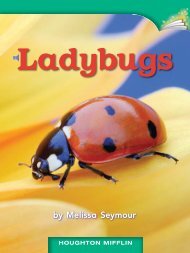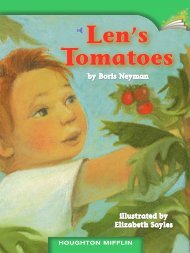Create successful ePaper yourself
Turn your PDF publications into a flip-book with our unique Google optimized e-Paper software.
Welcome to the <strong>Santa</strong> <strong>Fe</strong> <strong>Trail</strong>!Over 200 years ago, wagons loaded with goodstraveled on the <strong>Santa</strong> <strong>Fe</strong> <strong>Trail</strong>. On its eastern end,the trail began in Independence, Missouri. It ended780 miles later in <strong>Santa</strong> <strong>Fe</strong>, New Mexico. In the1800s, the trip took about eight weeks.COLORADOBent’sOld FortKANSASNEBRASKACouncilGroveIndependence<strong>Santa</strong> <strong>Fe</strong>FortUnionCimarron CutoffOKLAHOMAMISSOURINEW MEXICOTEXASThe <strong>Santa</strong> <strong>Fe</strong> <strong>Trail</strong>Today, people travel at a faster pace betweenIndependence and <strong>Santa</strong> <strong>Fe</strong>. A car trip takes abouttwo days. If you slow down and look closely, youcan spot ruts near the highway. The wheels ofthousands of wagons rolling along the <strong>Santa</strong> <strong>Fe</strong><strong>Trail</strong> made those deep cuts in the ground.Let’s visit four stops on the <strong>Santa</strong> <strong>Fe</strong> <strong>Trail</strong>.3
First Stop: Council Grove, KansasToday, the main street of Council Grove,Kansas, follows the historic route of the <strong>Santa</strong> <strong>Fe</strong><strong>Trail</strong>. For hundreds of years, people have gatheredin this area. The Neosho River provided water. Itwas easy to cross, too, because the bottom is linedwith hard, flat rocks. Horses and other animalshad plenty of tall grass to graze on.Undoubtedly, trees were one of the mostimportant resources around Council Grove. Peoplemet in the shade of huge oak trees and used thewood for fuel and shelter.4
“Last Chance” might be another good namefor Council Grove. The town offered the lastchance for people to buy supplies and fix theirwagons before heading west on the <strong>Santa</strong> <strong>Fe</strong> <strong>Trail</strong>.Today, you can visit the Last Chance Store. It wasbuilt in 1857 out of limestone.Probably the only calaboose, or jail, along the<strong>Santa</strong> <strong>Fe</strong> <strong>Trail</strong> was in Council Grove. You can stillvisit the wooden Early Day Calaboose today.6People Along the <strong>Trail</strong>Seth M. HaysSeth Hays founded the townof Council Grove in 1858. Hewas the great-grandson ofDaniel Boone, the Kentuckypioneer. Hays started bytrading with the Kaw Indiansin the area. Then, in 1857, heopened Hays House, which isthe oldest continuously runrestaurant west of the MississippiRiver. It is evident that HaysHouse was a success!
Bent’s Old Fort National Historic Site in Colorado hasa reconstructed 1840s trading post.Second Stop: Bent’s Old Fort, ColoradoAfter leaving Council Grove, travelers on the<strong>Santa</strong> <strong>Fe</strong> <strong>Trail</strong> crossed the grassy stretches of theGreat Plains. Their next major stop on the trailwas Bent’s Old Fort in the southeastern corner ofColorado. The snow-covered Rocky Mountainsrose in the distance. Some people must havethought the mountain peaks were mirages, butthey were real. William and Charles Bent andCeron St. Vraun built the fort in 1833.Plains Indians, trappers, traders, and explorersall met at Bent’s Old Fort. The oxen that shuffledalong the trail pulling the heavy wagons restedand ate prairie grass here.7
The most important trade at Bent’s Old Fortwas buffalo robes.The United States and Mexico went to warin 1846. The Army of the West stayed at Bent’sOld Fort. Then, in 1849, the fort was destroyed.No one knows what really happened. Greedmay have been a factor. Some think thatWilliam Bent blew up the fort. He wanted tosell it to the army, but the army would not givehim enough money.88
Third Stop: Fort Union, New MexicoThe next major stop on the trail is Fort Union.The <strong>Santa</strong> <strong>Fe</strong> <strong>Trail</strong> had two branches. The Mountainbranch took travelers to Bent’s Old Fort. The shorterbranch, called the Cimarron Cutoff, cut through thetip of what is now the Oklahoma Panhandle. FortUnion was built at the western point where thesetwo branches met again.Like Council Grove and Bent’s Old Fort, FortUnion is located on the Great Plains near a river.The Turkey Mountains rise in the distance. Thetrees in these mountains are not stunted. Thepines and junipers grow tall on their slopes.Fort Union, New Mexico, was a place to get suppliesas well as a military post.9
People Along the <strong>Trail</strong>Julia Archibald HolmesJulia Archibald Holmes and her husbandtraveled west on the <strong>Santa</strong> <strong>Fe</strong> <strong>Trail</strong> in1858. Holmes was the first womanknown to have climbed to the top ofPike’s Peak in Colorado. She said, “Nearlyeveryone tried to discourage me fromattempting it, but I believed that I shouldsucceed.” The couple continued onto <strong>Santa</strong> <strong>Fe</strong>. There, Julia ArchibaldHolmes became a writer for a NewYork newspaper.Traffic on the <strong>Santa</strong> <strong>Fe</strong> <strong>Trail</strong> was heavy until1880. Then the railroad reached <strong>Santa</strong> <strong>Fe</strong>. Peoplecould travel by train more quickly than they couldby wagon.12
Soon grass grew over the wagon ruts in thetrail, and it was almost forgotten. The people wholived in Council Grove and <strong>Santa</strong> <strong>Fe</strong> and who hadvisited Bent’s Old Fort and Fort Union were itssalvation. They remembered how important the<strong>Santa</strong> <strong>Fe</strong> <strong>Trail</strong> was. They kept the story of the trailalive. Today, visitors to these four stops along thetrail learn some of the history of the brave peoplewho traveled through the Old West.Today tourists can see history come alive at Bent’s Old Fort.Locals portray settlers from the 1800s.13
Glossaryfort a strong building that can be defended against attacksby an enemyGreat Plains the large grassland area of central NorthAmericaPanhandle a narrow strip of land sticking out from alarger, broader area, as in Texas and Oklahomaprairie flat or rolling land covered with grass and havingfew or no treesrepresentative a person chosen to speak or act for othersresource the wealth of a countrytrader a person who buys and sells things as a businesstrapper a person who traps wild animals for their furtreaty a formal agreement between groups or countries14
RespondingTARGET VOCABULARY Word Builder Think ofsome animals that shuffle. When might a personshuffle? Make a chart listing things that shuffle. Inthe first column, tell what shuffles. In the secondcolumn, list why the animal or person shuffles.Copy this chart and add more words.What ShufflesoxenWhypull heavy loadsWrite About ItText to Self Write a paragraph that describesoxen pulling a heavy load along the <strong>Santa</strong> <strong>Fe</strong> <strong>Trail</strong>.Visualize it. Tell what the oxen look like, what theyare pulling, and why it is hard work for them. Usewords from your chart in your writing.15
TARGET VOCABULARYevidentfactormiragespacesalvationseepshuffledstuntedundoubtedlyvainTARGET STRATEGY Visualize Use text details toform pictures in your mind of what you are reading.This vocabulary word is a homophone.It sounds just like another word but has a differentmeaning and spelling. One word tells which way thewind is blowing. What is the other word?16
Level: SDRA: 40Social StudiesStrategy:VisualizeWord Count: 1,2245.5.21 Build VocabularyHOUGHTON MIFFLINOnline Leveled BooksISBN-13:978-0-547-02659-6ISBN-10:0-547-02659-51032638



